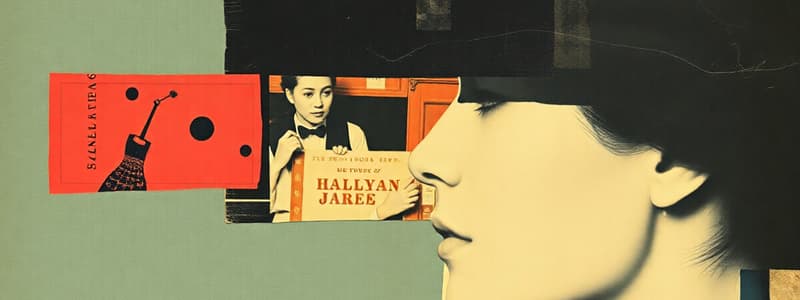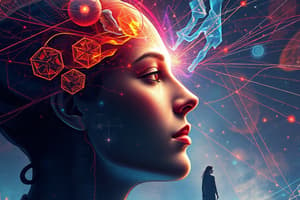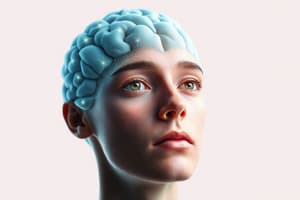Podcast
Questions and Answers
What are the two main functions of our senses?
What are the two main functions of our senses?
- Knowledge and understanding
- Survival and sensuality (correct)
- Memory and recall
- Communication and perception
Sensations begin as a result of stimulation of which type of neurons?
Sensations begin as a result of stimulation of which type of neurons?
- Interneurons
- Sensory neurons (correct)
- Motor neurons
- Reflex neurons
How is perception defined in the context of sensory processes?
How is perception defined in the context of sensory processes?
- The simple awareness of stimuli
- The interaction of multiple sensory inputs
- The storage of sensory memories
- The elaboration and interpretation of sensory experiences (correct)
What role do our sense organs play in our lives?
What role do our sense organs play in our lives?
Which of the following is NOT one of the common features of all senses?
Which of the following is NOT one of the common features of all senses?
What does the statement 'colors do not really exist out there' imply?
What does the statement 'colors do not really exist out there' imply?
Which additional senses might exist beyond the traditional five?
Which additional senses might exist beyond the traditional five?
What factor significantly influences perception according to the provided information?
What factor significantly influences perception according to the provided information?
What is the term for the physical object in the world from which stimuli are derived?
What is the term for the physical object in the world from which stimuli are derived?
Which psychological processes influence perception according to the content provided?
Which psychological processes influence perception according to the content provided?
What does the proximal stimulus represent in the perception process?
What does the proximal stimulus represent in the perception process?
What is primarily involved in determining the distal stimulus?
What is primarily involved in determining the distal stimulus?
In the process of perception, what does 'perceptual synthesis of features' refer to?
In the process of perception, what does 'perceptual synthesis of features' refer to?
Which of the following is NOT a step in the perception process as described?
Which of the following is NOT a step in the perception process as described?
Which stage of perception involves evaluating the characteristics of stimuli?
Which stage of perception involves evaluating the characteristics of stimuli?
What is the relationship between perception and recognition as described?
What is the relationship between perception and recognition as described?
What is the process of converting one form of energy into another in sensation called?
What is the process of converting one form of energy into another in sensation called?
What term refers to the minimum amount of physical energy required to produce a sensory experience?
What term refers to the minimum amount of physical energy required to produce a sensory experience?
How does background stimuli affect sensation?
How does background stimuli affect sensation?
What causes an individual to notice a sound that others do not, according to the given example?
What causes an individual to notice a sound that others do not, according to the given example?
In the context of sensation, what does difference threshold refer to?
In the context of sensation, what does difference threshold refer to?
Which of the following best describes the function of sensory systems?
Which of the following best describes the function of sensory systems?
What type of experience does sensation represent?
What type of experience does sensation represent?
Why might you fail to notice a stimulus that others can detect?
Why might you fail to notice a stimulus that others can detect?
What does the Muller-Lyer illusion demonstrate?
What does the Muller-Lyer illusion demonstrate?
Which term accurately describes an illusion as opposed to a hallucination?
Which term accurately describes an illusion as opposed to a hallucination?
What is an example of the Ponzo illusion?
What is an example of the Ponzo illusion?
What does 'selective attention' refer to?
What does 'selective attention' refer to?
How can divided attention impact an individual's performance?
How can divided attention impact an individual's performance?
Which of the following is NOT one of the three functions of attention?
Which of the following is NOT one of the three functions of attention?
What visual phenomenon occurs when standing between two railway tracks?
What visual phenomenon occurs when standing between two railway tracks?
Which illusion demonstrates a discrepancy between actual lengths and perceived lengths caused by arrow placement?
Which illusion demonstrates a discrepancy between actual lengths and perceived lengths caused by arrow placement?
What is the term for the minimum amount of change between two stimuli that can be recognized?
What is the term for the minimum amount of change between two stimuli that can be recognized?
Which principle is NOT a factor in perceptual organization?
Which principle is NOT a factor in perceptual organization?
What does depth perception allow an individual to do?
What does depth perception allow an individual to do?
What is perceptual consistency?
What is perceptual consistency?
Which of the following describes selective attention?
Which of the following describes selective attention?
The ability of the eyes to see in three-dimensional space is known as what?
The ability of the eyes to see in three-dimensional space is known as what?
What is the absolute threshold?
What is the absolute threshold?
Extra-sensory perception (ESP) primarily refers to what?
Extra-sensory perception (ESP) primarily refers to what?
Flashcards are hidden until you start studying
Study Notes
Sensory Processes: Attention and Perception
- Five primary sense organs: eyes (vision), ears (hearing), skin (touch), nose (smell), and tongue (taste).
- Functions of senses include survival and sensuality, enriching life experiences.
- Colors and perceptions of the world are products of sensory and perceptual processes, not inherent properties of objects.
- Sensation is the transformation of external energy (like light) into neural impulses that create an awareness of conditions.
- Perception involves the elaboration and interpretation of sensory information, influenced by past and present experiences.
Sensation
- Sensation is the conversion of one form of energy into another, enabling the brain to process sensory events.
- Different thresholds exist:
- Absolute Threshold: Minimum physical energy required for a sensory experience.
- Difference Threshold: Minimal change in stimulus intensity that can be detected.
- Background stimuli can affect sensation, as seen with stars being visible only at night due to the daylight background.
- Expectations and experiences guide sensation, making it a complex process beyond a simple binary detection.
- Distal stimulus refers to the real-world object, while the proximal stimulus is the resulting optical image on the retina.
Perception
- Major task of perception: interpreting proximal stimuli to identify distal stimuli and understand the outside world.
- Perception involves recognizing physical properties (shape, size) alongside past experiences and cognitive processes.
- The process of perception includes:
- Sensory processes
- Environmental stimulation
- Analysis and identification of stimuli
- Perceptual synthesis and organization
Illusions and Hallucinations
- Illusions involve distorted perceptions of stimuli that do exist, while hallucinations involve perceiving non-existent stimuli.
- Classic examples of illusions include the Muller-Lyer illusion and the Ponzo illusion, which demonstrate how our perception can be misleading.
Attention
- Attention is critical for focusing on specific sensory messages amidst distractions.
- Types of attention:
- Divided Attention: Attempting to focus on multiple stimuli simultaneously, which can lead to accidents.
- Selective Attention: Prioritizing specific incoming sensory information while filtering out others.
- Functions of attention include serving as a sensory filter, response selection, and enabling consciousness.
Key Concepts
- Perceptual organization depends on several determinants such as figure-ground organization and perceptual consistency.
- Perceptual Constancy: Recognition that an object's characteristics (shape, size, brightness) remain stable despite changes in the retinal image.
- Depth Perception: The ability to perceive three-dimensional space and accurately judge distances, crucial for activities like driving and catching objects.
Additional Insights
- Mechanisms of attention and perception impact everyday life and inform various applications in psychology, art, and design.
- Exploring extra-sensory perception can lead to understanding phenomena beyond traditional sensory modalities.
Studying That Suits You
Use AI to generate personalized quizzes and flashcards to suit your learning preferences.




